Wednesday, 15 June 2011: Collonges au Mont d'Or to Vienne
Written 4 July 2011
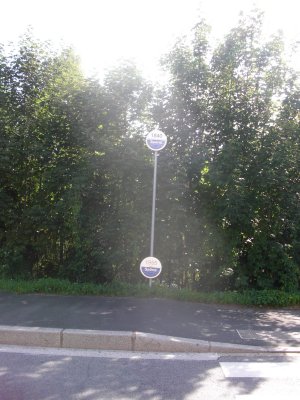
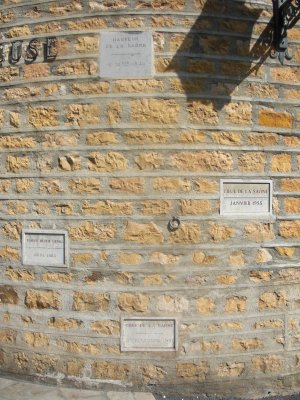 Throughout our time in and near Lyon we'd been hearing about the enormous floods to which the city is no longer subject, so the first order of the day was to photograph the high-water marks outside our hotel and those at last night's restaurant. At the left are two that stand on the sidewalk directly across from the hotel; traffic was light, so I stood in the roadway briefly to take the photo. (Yes, I know I don't pay enough attention to the position of the sun when I take photos, so I'm forever getting sun flares, but darn it, I want those images, and it's not like we could wait around until 2 p.m. to get the run into the right place.) The one at the bottom, from 1955, is about knee high as you stand on the sidewalk, which is, itself a good 30 feet above the river's current level. (The trees you can see behind the sign are growing on the river bank, which slopes almost vertically from the sidewalk to the water.) The upper sign, well over my head, is from the flood of 1840, the highest on record.
Throughout our time in and near Lyon we'd been hearing about the enormous floods to which the city is no longer subject, so the first order of the day was to photograph the high-water marks outside our hotel and those at last night's restaurant. At the left are two that stand on the sidewalk directly across from the hotel; traffic was light, so I stood in the roadway briefly to take the photo. (Yes, I know I don't pay enough attention to the position of the sun when I take photos, so I'm forever getting sun flares, but darn it, I want those images, and it's not like we could wait around until 2 p.m. to get the run into the right place.) The one at the bottom, from 1955, is about knee high as you stand on the sidewalk, which is, itself a good 30 feet above the river's current level. (The trees you can see behind the sign are growing on the river bank, which slopes almost vertically from the sidewalk to the water.) The upper sign, well over my head, is from the flood of 1840, the highest on record.
The photo on the right, of the retaining wall next to the steps up to the entrance of Bocuse's restaurant, shows four. From the bottom up, they commemorate the floods of December (Christmas Day!) 1981, June 1983, January 1955, and 5 November 1840.
After our brief trip south to get that photo, we turned around and headed north, away from Lyon—waving to our hotel on the way by (it clearly caters to businessmen—it's breakfast is served 6-9 a.m., rather than 7:30-11 a.m. as in the tourist hotels—it has a small restaurant with a terrace in a small sunken garden between the building and its parking lot; nice people; good little place altogether and way cheaper than the places recommended on Bocuse's website)—over the river well north of Collonges, and way out around Lyon to the east. We were headed for Vienne, on the Rhône directly south of Lyon, but we wanted nothing to do with the traffic patterns of the agglomeration on our way, so we swung a wide arc.
We crossed mostly flat country, which managed to be both industrial and agricultural, all at once. Large corporate headquarters were set out in the middle of grain fields. Long lines of gigantic high-tension towers marched across the landscape, their feet in cornfields. Eventually, we came to the source of all the electric lines—a huge nuclear power station with four cooling towers. Electricity was clearly pouring out of it, off across the countryside toward Lyon. No grapevines in sight.
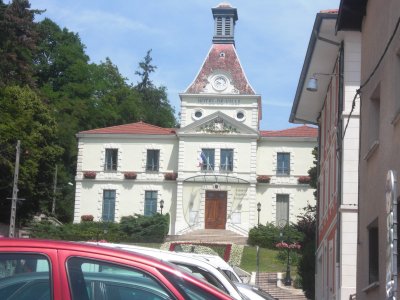
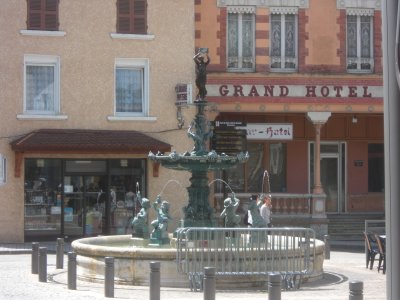 We stopped for lunch in a small town called Crémieu. Looking one direction from our little table on the deck (the sidewalk wan't level enough for tables, so the restaurant built a deck), we could see the town hall, shown here at the left. Looking the other way, the view was of this fountain.
We stopped for lunch in a small town called Crémieu. Looking one direction from our little table on the deck (the sidewalk wan't level enough for tables, so the restaurant built a deck), we could see the town hall, shown here at the left. Looking the other way, the view was of this fountain.
It was so windy that day that each table was set with paper placemats on which the knife had been slotted between the tines of the fork and the wine glass had been laid on its side and its foot also engaged in the tines of the fork so that it wouldn't be rolled off the table.
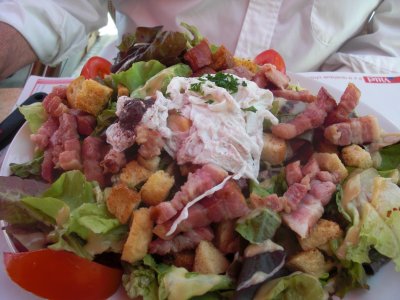
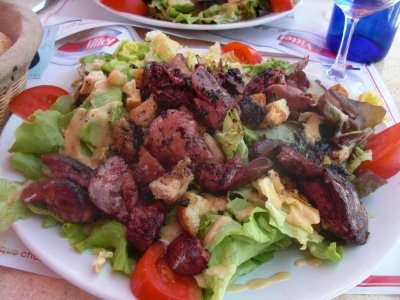 David ordered yet another salade Lyonnaise, whereas I jumped at the chance to get another salade Bressane, with the chicken livers. Not as good as the last but pretty darn good anyway.
David ordered yet another salade Lyonnaise, whereas I jumped at the chance to get another salade Bressane, with the chicken livers. Not as good as the last but pretty darn good anyway.
David had a decaf while I had ice cream for dessert.
Inside the restaurant was a home-made poster setting forth the successes of the 2010 hunting season for the hunting club the owner belongs to. They apparently bagged three (impressively large, from the photos; 72, 75, and 91 kg) wild boars this year. Gary got two of them, and Gilbert the third (his first ever). The photos showed from 10 to 15 guys posing with each one. Aside from that, the place was decorated mainly with posters and memorabilia of Johnny Hallyday (the French Elvis, I'm told).
Then on to Vienne. As usual, the transition from our large-scale Michelin road map to my little Google area maps was a little tricky, but I successfully guessed which radius we were coming in on (down an impressive grade between some spectacular topographical features) and successfully navigated us through a huge rotary that controls basically all the traffic in town and right to the door of our hotel, where we found not only no place to park but no place even to stop. I bailed out to go talk to the people at reception while David circled the block looking for a space. The "block" was actually a pair of streets, one-way in opposite directions, with the rotary at the downhill end, a small parking lot at the uphill end, and nothing between them but a broad, paved, tree-shaded median full of park benches and café tables, so he could go round and round without getting lost or shunted off in some unexpected direction.
While I conferred with the desk, he found a parking space on the far side of the median, about a block away—fortunately, a diagonal one, as our parallel-parking skills have atrophied in Tallahassee, and as, besides, French parking spaces are much smaller than American ones, even in proportion to the cars. We were able to trundle our luggage from there to the hotel. The hotel folks recommended a nearby parking garage (opening pretty much directly off the far side of the giant rotary), so we moved the car there and parked it for the duration.
Next stop, of course, was the Office de Tourisme, on the river bank about four blocks away, at right angles to our double street. As we approached the river, what was the first thing that met our eyes? Large as life, the Swiss Pearl last spotted tied up on the east bank of the Rhône in Lyon, during our first river cruise! In the next couple of days, we ran into many parties of her passengers, mostly British, as far as we could tell, though one group, apparently Germans, may have been with the Pearl as well. They were some sort of social club and wore matching black suits (skirts for the women), black bowler hats, and many and varied round badges (like campaign buttons) on their clothes and hats. They looked like comic-opera race-track bookies (or Laurel and Hardy), and we never figured out who or what they really were.
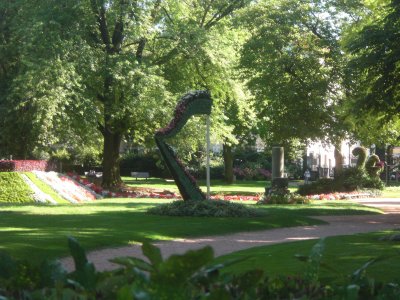
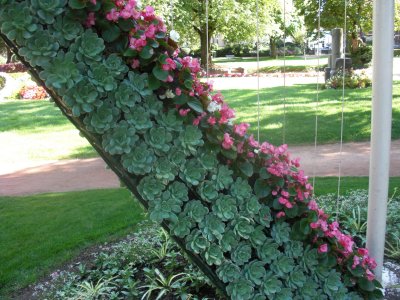 The friendly and helpful folks at the tourist office equipped us with maps and brochures (including one for an audioguided tour of the town) and any amount of information about opening times, etc., but it was too late in the day to embark on any of them then. Instead, we explored the beautiful city park behind the tourist office, where we discovered this amazing life-size "topiary" harp (not actually a topiary, as the plants are installed on a frame, but terrific nonetheless). The right-hand photo is a close-up of part of it.
The friendly and helpful folks at the tourist office equipped us with maps and brochures (including one for an audioguided tour of the town) and any amount of information about opening times, etc., but it was too late in the day to embark on any of them then. Instead, we explored the beautiful city park behind the tourist office, where we discovered this amazing life-size "topiary" harp (not actually a topiary, as the plants are installed on a frame, but terrific nonetheless). The right-hand photo is a close-up of part of it.
We also found a tree hung with insect traps. A sign next to it says (in my translation): "Faced with aphids, no problem. The solution is chemical-free with integrated biological control, armed with ladybugs, deer flies, but also vegetable oil and pheromone traps, all techniques inspired by nature to ensnare, capture, and destroy the predators. It works here; why not where you live?"
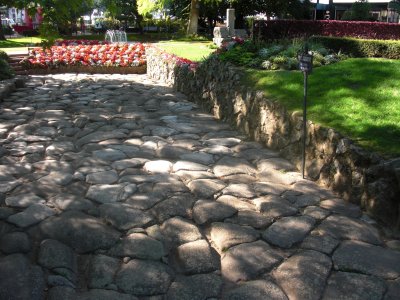
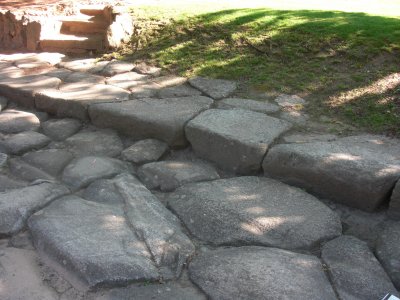 The park's best feature, though, was this actual section of Roman road, discovered in 1895 during its (the park's, not the road's) construction. The ground has shifted and settled since the road was built, so its surface is no longer as smooth as it was originally, but in the right-hand photo, near where the roadway meets the curb, you can see the remains of actual wheel ruts. In person, you could see many of them, worn right into the rock.
The park's best feature, though, was this actual section of Roman road, discovered in 1895 during its (the park's, not the road's) construction. The ground has shifted and settled since the road was built, so its surface is no longer as smooth as it was originally, but in the right-hand photo, near where the roadway meets the curb, you can see the remains of actual wheel ruts. In person, you could see many of them, worn right into the rock.
Both our restaurants were within walking distance, so after freshening up at the hotel, we walked north to the first of them, l'Estancot, which the proprietor tells me means "the little hole-in-the-wall eatery." It was on a tiny, steep, necessarily pedestrian street (cars could not have handled the grade even if they could have fit), and again its outdoor tables were on a deck because the sidewalk was at about a 30-degree angle. All evening, the proprietor and the waitress stepped onto and off of that deck, at a point where it was about two feet off the ground. David was on the point of stopping the waitress and saying, "Don't you realize that if you keep stepping off like that, onto those cobblestones, at that speed, you'll need knee replacements by the time you're fifty?!"
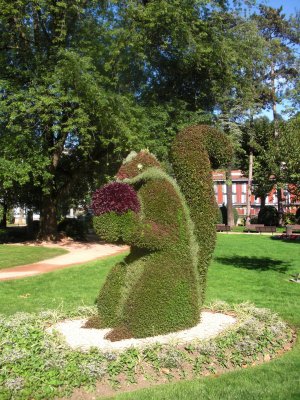
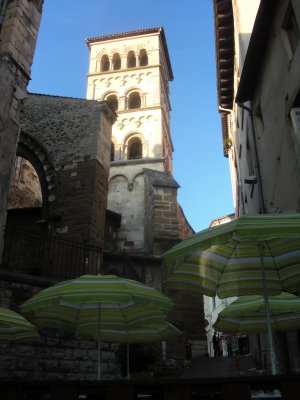 Here, for fun, is one last photo from the park, of the six-foot topiary squirrel just visible in the background of the photo of the harp.
Here, for fun, is one last photo from the park, of the six-foot topiary squirrel just visible in the background of the photo of the harp.
At the right is the view from our supper table, tower of St. André le Bas (St. Andrew the Lower, as opposed to St. Andrew the Upper, up on a hill elsewhere in town). Swifts swarmed around the tower, screeching all evening—the sound of summer in France. The green unbrellas belong to the restaurant next door, uphill of us. Our restaurant filled completely, while the one with the umbrellas remained entirely empty all evening— not one customer.
The restaurant is small and much less formal than many we'd been frequenting, and its specialty is "criques," pronounced "creek" in both the singular and the plural—hash browned potato cakes. They have other menu items, but their mainstay is potato cakes with stuff on them. They define a "crique" as shredded potatoes, salt, parsley, garlic, and egg, fried into a cake crispy on both sides. A "paillasson" (straw mattress) is the same thing but consisting solely of potatoes and salt.
After the previous night's huge dinner, we decided to go easy for once. We skipped the starter and each ordered the menu consisting of a crique or paillason dish followed by either cheese or dessert.
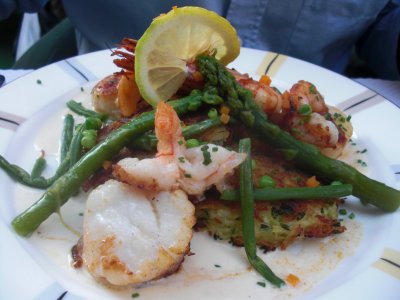
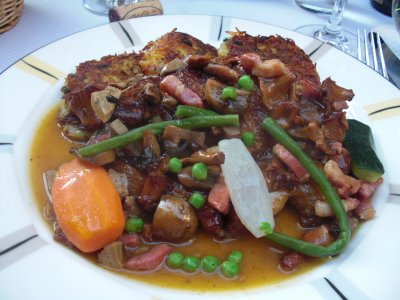 David ordered the crique Gourmandine (topped with scallops, gambas, green beans, and asparagus).
David ordered the crique Gourmandine (topped with scallops, gambas, green beans, and asparagus).
I chose the "criq'aille" (topped with a quail "crapaudine" style, i.e., spatchcocked, split open, flattened, and grilled in what is supposed to be the shape of a toad), in turn topped with a jus of foie gras and pieces of zucchini, carrot, and turnip, green beans, peas, mushrooms, and lots of lardons; the quail really is in there, but you can't see it under all the other stuff).
Both excellent, and I'm pretty sure I could make "criques" at home.
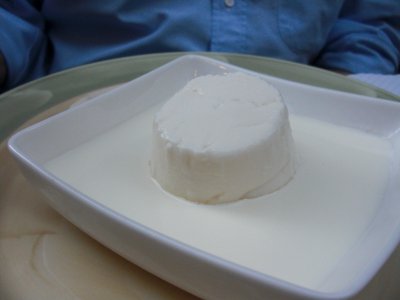
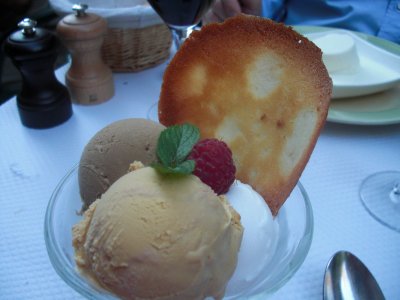 For the second course, David chose cheese and as usual got himself a faisselle of fromage blanc with cream.
For the second course, David chose cheese and as usual got himself a faisselle of fromage blanc with cream.
From the proprietor's recited list of the desserts, I chose ice cream, and after I asked what flavors she had, we sat open-mouthed while she recited, slowly and distinctly, from memory and without hesitation, about 30 flavors (I wish I'd counted them), all made in house. David actually applauded! Then she said, with a twinkle in her eye, "Hope you didn't want any other flavors, 'cause that's all I've got." I chose coffee, caramel, and coconut, which came garnished as you see, with a raspberry, mint leaf, and home-made sugar cookie. Delicious!
During our main course, a calico cat, thin but not emaciated, trotted by down the street, clearly on business of her own. During dessert, she trotted back up the other way. My theory was closing time at a fish market down on the quai, where she was accustomed to show up for her habitual fish head.
On the way back to the hotel, we walked along the quai and notice several appartment house in typical Art Deco style, but they seemed so spanking new that we wondered whether it was actually neo-Art Deco.
previous entry
List of Entries
next entry

 Throughout our time in and near Lyon we'd been hearing about the enormous floods to which the city is no longer subject, so the first order of the day was to photograph the high-water marks outside our hotel and those at last night's restaurant. At the left are two that stand on the sidewalk directly across from the hotel; traffic was light, so I stood in the roadway briefly to take the photo. (Yes, I know I don't pay enough attention to the position of the sun when I take photos, so I'm forever getting sun flares, but darn it, I want those images, and it's not like we could wait around until 2 p.m. to get the run into the right place.) The one at the bottom, from 1955, is about knee high as you stand on the sidewalk, which is, itself a good 30 feet above the river's current level. (The trees you can see behind the sign are growing on the river bank, which slopes almost vertically from the sidewalk to the water.) The upper sign, well over my head, is from the flood of 1840, the highest on record.
Throughout our time in and near Lyon we'd been hearing about the enormous floods to which the city is no longer subject, so the first order of the day was to photograph the high-water marks outside our hotel and those at last night's restaurant. At the left are two that stand on the sidewalk directly across from the hotel; traffic was light, so I stood in the roadway briefly to take the photo. (Yes, I know I don't pay enough attention to the position of the sun when I take photos, so I'm forever getting sun flares, but darn it, I want those images, and it's not like we could wait around until 2 p.m. to get the run into the right place.) The one at the bottom, from 1955, is about knee high as you stand on the sidewalk, which is, itself a good 30 feet above the river's current level. (The trees you can see behind the sign are growing on the river bank, which slopes almost vertically from the sidewalk to the water.) The upper sign, well over my head, is from the flood of 1840, the highest on record.
 We stopped for lunch in a small town called Crémieu. Looking one direction from our little table on the deck (the sidewalk wan't level enough for tables, so the restaurant built a deck), we could see the town hall, shown here at the left. Looking the other way, the view was of this fountain.
We stopped for lunch in a small town called Crémieu. Looking one direction from our little table on the deck (the sidewalk wan't level enough for tables, so the restaurant built a deck), we could see the town hall, shown here at the left. Looking the other way, the view was of this fountain.
 David ordered yet another salade Lyonnaise, whereas I jumped at the chance to get another salade Bressane, with the chicken livers. Not as good as the last but pretty darn good anyway.
David ordered yet another salade Lyonnaise, whereas I jumped at the chance to get another salade Bressane, with the chicken livers. Not as good as the last but pretty darn good anyway.
 The friendly and helpful folks at the tourist office equipped us with maps and brochures (including one for an audioguided tour of the town) and any amount of information about opening times, etc., but it was too late in the day to embark on any of them then. Instead, we explored the beautiful city park behind the tourist office, where we discovered this amazing life-size "topiary" harp (not actually a topiary, as the plants are installed on a frame, but terrific nonetheless). The right-hand photo is a close-up of part of it.
The friendly and helpful folks at the tourist office equipped us with maps and brochures (including one for an audioguided tour of the town) and any amount of information about opening times, etc., but it was too late in the day to embark on any of them then. Instead, we explored the beautiful city park behind the tourist office, where we discovered this amazing life-size "topiary" harp (not actually a topiary, as the plants are installed on a frame, but terrific nonetheless). The right-hand photo is a close-up of part of it.
 The park's best feature, though, was this actual section of Roman road, discovered in 1895 during its (the park's, not the road's) construction. The ground has shifted and settled since the road was built, so its surface is no longer as smooth as it was originally, but in the right-hand photo, near where the roadway meets the curb, you can see the remains of actual wheel ruts. In person, you could see many of them, worn right into the rock.
The park's best feature, though, was this actual section of Roman road, discovered in 1895 during its (the park's, not the road's) construction. The ground has shifted and settled since the road was built, so its surface is no longer as smooth as it was originally, but in the right-hand photo, near where the roadway meets the curb, you can see the remains of actual wheel ruts. In person, you could see many of them, worn right into the rock.
 Here, for fun, is one last photo from the park, of the six-foot topiary squirrel just visible in the background of the photo of the harp.
Here, for fun, is one last photo from the park, of the six-foot topiary squirrel just visible in the background of the photo of the harp. 
 David ordered the crique Gourmandine (topped with scallops, gambas, green beans, and asparagus).
David ordered the crique Gourmandine (topped with scallops, gambas, green beans, and asparagus).
 For the second course, David chose cheese and as usual got himself a faisselle of fromage blanc with cream.
For the second course, David chose cheese and as usual got himself a faisselle of fromage blanc with cream.